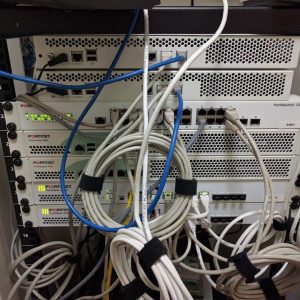High Availability
FGCP supports BFD enabled BGP graceful restart after an HA failover (255574)
If an HA cluster is part of a Border Gateway Protocol (BGP) bidirectional forwarding detection (BFD) configuration where both the cluster and the BGP static neighbor are configured for graceful restart, after an HA failover BGP enters graceful restart mode and both the cluster and the BGP neighbor keep their BGP routes.
To support HA and BFD enabled BGP graceful:
l From the cluster, configure the BFD enabled BGP neighbor as a static BFD neighbor using the config router bfd command.Set the BGP auto-start timer to 5 seconds so that after an HA failover BGP on the new primary unit waits for 5 seconds before connect to its BFD neighbors, and then registers BFD requests after establishing the connections. With static BFD neighbors, BFD requests and sessions can be created as soon as possible after the failover.The command get router info bfd requests shows the BFD peer requests.
l The BFD session created for a static BFD neighbor/peer request initializes its state as INIT instead of DOWN and its detection time as bfd-required-min-rx * bfd-detect-mult msecs.
l When a BFD control packet with a nonzero Your Discriminator (your_discr) value is received, if no session can be found to match the your_discr, instead of discarding the packet, other fields in the packet, such as addressing information, are used to choose one session that was just initialized, with zero as its remote discriminator.
l When a BFD session in the UP state receives a control packet with zero as Your Discriminator and DOWN as State, the session changes its state to DOWN but will not notify this DOWN event to BGP and/or other registered clients.
FRUP is not supported by FortiOS 5.4 (295198)
With the changes to switch mode, FRUP is no longer available on the FortiGate-100D.
VOIP application control sessions are no longer blocked after an HA failover (273544)
After an HA failover, VoIP sessions that are being scanned by application control will now continue with only a minor interruption, if any. To support this feature, IPS UDP expectation tables are now synchronized between cluster units.
Firewall local-in policies are supported for the dedicated HA management interface (276779
246574)
To add local in polices for the dedicated management interface, enable ha-mgmt-inft-only and set intf to any. Enabling ha-mgmt-intf-only means the local-in policy applies only to the VDOM that contains the dedicated HA management interface.
config firewall local-in-policy edit 0
set ha-mgmt-intf-only enable set intf any
etc… end
HA heartbeat traffic set to the same priority level as data traffic (276665)
Local out traffic, including HA heartbeat traffic, is now set to high priority to make sure it is processed at the same priority level as data traffic. This change has been made because HA heartbeat traffic can be processed by NP6 processors that are also processing data traffic. When HA heartbeat traffic was set to a lower priority it may have be delayed or dropped by very busy NP6 processors resulting in HA failovers.
FGSP CLI command name changed (262340)
The FortiOS 5.2 command config system session-sync has been changed in FortiOS 5.4 to config system cluster-sync. Otherwise the command syntax is the same and the config system ha commands used for FGSP settings have not changed.
FGSP now supports synchronizing IPsec sessions (262340)
The FGSP now synchronizes IPsec tunnels between FortiGates in an FGSP configuration. IPsec tunnel synchronization synchronizes keys and other run time data between the FortiGates in an FGSP configuration. No additional configuration is required to synchronize IPsec sessions. Also you cannot disable IPsec tunnel synchronization.
The FGSP synchronizes IPsec keys and other runtime data but not actual tunnel sessions. This means that if one of the cluster units goes down the cluster unit that is still operating can quickly get IPsec tunnels re-established without re-negotiating them but all existing tunnel sessions on the failed FortiGate have to be restarted on the still operating FortiGate.
IPsec tunnel sync only supports dialup IPsec. The interfaces on both FortiGates that are tunnel endpoints must have the same IP addresses and external routers must be configured to load balance IPsec tunnel sessions to the FortiGates in the cluster.
Monitoring VLAN interfaces (220773)
When operating in HA mode and if you have added VLAN interfaces to the FortiGates in the cluster, you can use the following command to monitor all VLAN interfaces and send a message if one of the VLAN interfaces is found to be down.
config system ha-monitor
set monitor-vlan enable/disable
set vlan-hb-interval <interval_seconds>
set vlan-hb-lost-threshold <vlan-lost-heartbeat-threshold>
end
Once configured, this feature works by verifying that the primary unit can connect to the subordinate unit over each VLAN. This verifies that the switch that the VLAN interfaces are connected to is configured correctly for each VLAN. If the primary unit cannot connect to the subordinate unit over one of the configured VLANs the primary unit writes a link monitor log message indicating that the named VLAN went down (log message id 20099).
FortiGate HA cluster support for managed switches (276488 266084)
Added the capability to support managed switches from a FortiGate HA cluster. If a standby FortiGate becomes active, it automatically establishes connectivity with the managed switches. See Managing a FortiGate with a FortiSwitch for details.
HA cluster health displayed on the Unit Operation dashboard widget (260547)
The Unit Operation dashboard widget now includes the serial number and hostname of all of the FortiGate units in the cluster as well as an indication of the sync status of each cluster member.


